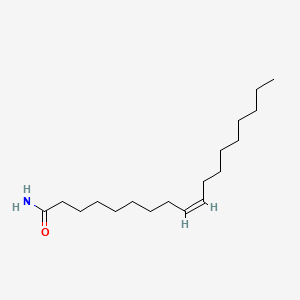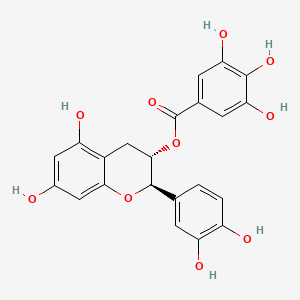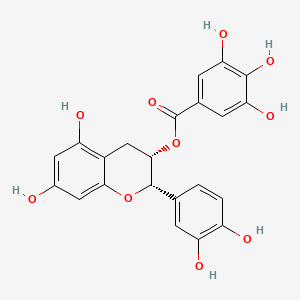Possible associated with:
| Structure | name | description | Reference count |
|---|---|---|---|

|
acetic acid | acetic acid is a lipid of Fatty Acyls (FA) class. Acetic acid is associated with abnormalities such as Vitamin B 12 Deficiency. The involved functions are known as Excretory function. The related lipids are Propionate. | 89633 |

|
17-octadecynoic acid | 17-octadecynoic acid is a lipid of Fatty Acyls (FA) class. 17-octadecynoic acid is associated with abnormalities such as Renal tubular disorder, Hypertensive disease, abnormal fragmented structure, Blood Clot and Subarachnoid Hemorrhage. The involved functions are known as Hypoxia, Pathological Dilatation, Anabolism, Biochemical Pathway and Stimulus. 17-octadecynoic acid often locates in Endothelium, Muscle, Protoplasm, Microsomes and Membrane. The associated genes with 17-octadecynoic acid are P4HTM gene, EDNRA gene, Gene Family, IMPACT gene and PPP1R1A gene. The related lipids are 17-octadecynoic acid, Fatty Acids, 1-oleoyl-2-acetoyl-sn-glycerol and fatty acid analog. | 308 |

|
Lipoic acid | Lipoic acid is a lipid of Fatty Acyls (FA) class. | 7940 |

|
Oleamide | Oleamide is a lipid of Fatty Acyls (FA) class. Oleamide is associated with abnormalities such as Blepharoptosis, BOSLEY-SALIH-ALORAINY SYNDROME, abnormal fragmented structure, Syndrome and Hashimoto Disease. The involved functions are known as Anabolism, Regulation, receptor ligand, Process and Binding (Molecular Function). Oleamide often locates in receptor complex, Tissue membrane, Membrane, annulus and Connexon. The associated genes with Oleamide are Homologous Gene, FAAH gene, FAAH2 gene, P4HTM gene and Integral Membrane Proteins. The related lipids are Fatty Acids, Membrane Lipids, N-acylethanolamines, erucyl amide and linoleamide. | 349 |

|
tacrolimus | Tacrolimus is a lipid of Polyketides (PK) class. Tacrolimus is associated with abnormalities such as Renal glomerular disease. The involved functions are known as inhibitors, Fungicidal activity, Metabolic Inhibition, Excretory function and Dephosphorylation. Tacrolimus often locates in Hepatic, Mitochondrial matrix and Inner mitochondrial membrane. The associated genes with Tacrolimus are RHOA gene and BGN gene. | 12730 |

|
(+)-Catechin 3-Gallate | (+)-Catechin 3-Gallate is a lipid of Polyketides (PK) class. (+)-catechin 3-gallate is associated with abnormalities such as Epilepsy and Megalencephaly. The involved functions are known as Docking, Drug Interactions, inhibitors, Oxidation and Inflammation Process. (+)-catechin 3-gallate often locates in Solitary microtubule component of centriole or axonemal complex, Palmar surface, Glial and peritoneal. The associated genes with (+)-Catechin 3-Gallate are Homologous Gene and TSC1 gene. | 456 |

|
(-)-Epicatechin gallate | (-)-Epicatechin gallate is a lipid of Polyketides (PK) class. (-)-epicatechin gallate is associated with abnormalities such as Infection, trachomatis, Heart Diseases, Influenza and Hypoglycemia. The involved functions are known as Cell Proliferation, Metabolic Inhibition, Anabolism, protein expression and Apoptosis. (-)-epicatechin gallate often locates in Tissue membrane, Membrane, soluble, Plasma membrane and Protoplasm. The associated genes with (-)-Epicatechin gallate are GDF15 gene, ATF3 gene, CRISP2 gene, Homologous Gene and activating transcription factor 3. The related lipids are Lipopolysaccharides. The related experimental models are Cancer Model and Mouse Model. | 645 |

|
Epicatechin-3-gallate | Epicatechin-3-gallate is a lipid of Polyketides (PK) class. Epicatechin-3-gallate is associated with abnormalities such as Epilepsy and Megalencephaly. The involved functions are known as Docking, Drug Interactions, inhibitors, Oxidation and Inflammation Process. Epicatechin-3-gallate often locates in Solitary microtubule component of centriole or axonemal complex, Palmar surface, Glial and peritoneal. The associated genes with Epicatechin-3-gallate are Homologous Gene and TSC1 gene. | 421 |

|
forskolin | Forskolin is a lipid of Prenol Lipids (PR) class. Forskolin is associated with abnormalities such as Cholestasis, Vocal cord dysfunction familial, Hypothyroidism, Renal tubular disorder and Disintegration (morphologic abnormality). The involved functions are known as Cell Proliferation, Anabolism, mRNA Expression, Agent and Signal. Forskolin often locates in Extracellular, Body tissue, Skin, Tissue membrane and Membrane. The associated genes with forskolin are P4HTM gene, SLC33A1 gene, NR1I2 gene, Genes, Reporter and CYP3A gene. The related lipids are Steroids, steroid sulfate, Fatty Acids, LYSO-PC and Lipopolysaccharides. | 24755 |
Total
9